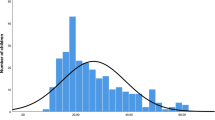Abstract
Lead exposure in children has received increasing attention from scientists and public health institutions worldwide. Deficiencies of nutritional essential metals can increase the hazard from lead exposure by enhancing absorption and toxicity of dietary lead. Lead, as a ubiquitous toxicity metal, may interact metabolically with nutritional essential metals. A large population-based study was conducted to investigate blood lead, calcium, iron, zinc and hemoglobin levels in healthy children aged 0–7 years. Based on the records, 158 (3.57 %) of 4,429 children had a blood lead levels (BLLs) ≥10 μg/dl, and 1,324 (30.30 %) children had a BLL ≥7 μg/dl. BLLs in children aged less than 3 years was lower than those in older children. BLLs had a negative correlation with blood calcium and iron level (r = −0.357 and r = −0.070, P < 0.01). Multiple logistic regression analysis also showed that BLLs had a negative correlation with blood calcium and iron. BLLs can be influenced by the status of some essential trace metals in children. Supplement of nutritional elements may help reduce lead absorption. Children with elevated BLLs (≥10 μg/dl) were controlled well in recent years in Chengdu. But the burden of reducing BLLs remains extremely arduous, which requires the joint efforts of both government agencies and the public.

Similar content being viewed by others
References
Pocock SJ, Shaper AC, Ashby D, Delves T, Whitehead TP (1984) Blood lead concentration, blood pressure, and renal function. Br Med J (Clin Res Ed) 289(6449):872–874
Daggett DA, Oberley TD, Nelson SA, Wright LS, Kornguth SE, Siegel FL (1998) Effects of lead on rat kidney and liver: GST expression and oxidative stress. Toxicology 128:191–206
Kuo HW, Hsiao TY, Lai JS (2001) Immunological effects of long-term lead exposure among Taiwanese workers. Arch Toxicol 75(10):569–573
Al-Neamy FR, Almehidi AM, Alwash R, Pasha MA, Ibrahim A, Bener A (2001) Occupational lead exposure and amino acid profiles and liver function tests in industrial workers. Int J Environ Health Res 11:181–188
Bonde JP, Joffe M, Apostoli P, Dale A, Kiss P, Spano M, Caruso F, Giwercman A, Bisanti L, Porru S, Vanhoorne M, Comhaire F, Zschiesche W (2002) Sperm count and chromatin structure in men exposed to inorganic lead: lowest adverse effect levels. Occup Environ Med 59:234–242
Lanphear BP, Hornung R, Khoury J, Yoltoon K, Baghurst P, Bellinger DC, Canfield R, Dietrich KN, Bornschein R, Greene T, Rothernber J, Needleman HL, Schnass L, Wasserman G, Graziano J, Roberts R (2005) Low level environmental lead exposure and children’s intellectual function: an international pooled analysis. Environ Health Perspect 113:894–899
Martin D, Glass TA, Bandeen-Roche K, Todd AC, Shi W, Schwartz BS (2006) Association of blood lead and tibia lead with blood pressure and hypertension in a community sample of older adults. Am J Epidemiol 163(5):467–478
D’souza HS, Geraldine M, Venkatesh T (2007) Evaluation, diagnosis, and treatment of lead poisoning in a patient with occupational lead exposure: a case presentation. J Occup Med Toxicol 24(2):7
Koller K, Brown T, Spurgeon A, Levy L (2004) Recent developments in low-level lead exposure and intellectual impairment in children. Environ Health Perspect 112(9):987–994
Mahaffey KR (1990) Environmental lead toxicity: nutrition as a component of intervention. Environ Health Perspect 89:75–78
US Centers for Disease Control (1991) Preventing lead poisoning in young children. US Centers for Disease Control, Atlanta
International Programme on Chemical Safety (IPCS) (1995) Inorganic lead. Environmental health criteria 165. WHO, Geneva
Zhang S, Dai Y, Xie X, Fan Z, Tan Z, Zhang Y (2009) Surveillance of childhood blood lead levels in 14 cities of China in 2004–2006. Biomed Environ Sci 22(4):288–296
Woolf AD, Goldman R, Bellinger DC (2007) Update on the clinical management of childhood lead poisoning. Pediatr Clin N Am 54:271–294
Warniment C, Tsang K, Galazka SS (2010) Lead poisoning in children. Am Fam Physician 81(6):751–757, 759–760
Jiang YM, Shi H, Li JY, Shen C, Liu JH, Yang H (2010) Environmental lead exposure among children in Chengdu, China: blood lead levels and major sources. Bull Environ Contam Toxicol 84:1–4
He KM, Wang S, Zhang JL (2009) Blood lead levels of children and its trend in China. Sci Total Environ 407:3986–3993
Goyer RA (1997) Toxic and essential metal interaction. Annu Rev Nutr 17:37–50
Centers for Disease Control (1991) Preventing Lead Poisoning in Young Children: a Statement by the Centers for Disease Control. US Dep. Health & Hum. Serv./Public Health Serv./CDC, Atlanta, p 35
Ahamed M, Singh S, Behari JR, Kumar A, Siddiqui MKJ (2007) Interaction of lead with some essential trace metals in the blood of anemic children from Lucknow, India. Clin Chim Acta 377:92–97
Kerper LE, Hinkle PM (1997) Cellular uptake if lead is activated by depletion of intracellular calcium stores. J Biol Chem 272:8346–8553
Author information
Authors and Affiliations
Corresponding author
Rights and permissions
About this article
Cite this article
Wang, H., Shi, H., Chang, L. et al. Association of Blood Lead with Calcium, Iron, Zinc and Hemoglobin in Children Aged 0–7 Years: A Large Population-Based Study. Biol Trace Elem Res 149, 143–147 (2012). https://doi.org/10.1007/s12011-012-9413-x
Received:
Accepted:
Published:
Issue Date:
DOI: https://doi.org/10.1007/s12011-012-9413-x




